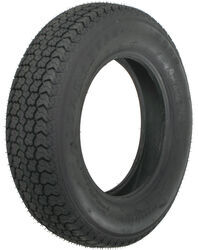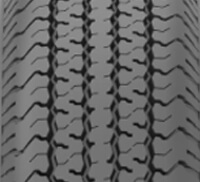
Ive had a more detailed look at the tyres in questionone of them has the severe wear pattern shown in my pics in the OP on the inside but also has a slightly lesser version of the same wear. If youre lacking in tire pressure on your trailer tires its going to show via wear on the inside and outside edges of the tire.

There is excessive camber in the suspension bent axle on trailers causing the wheel to lean too much to the inside or outside and putting too much load on one side of the tire.
Trailer tires wearing on inside edge. If the trailer tires are dead flat on the ground without weight on the trailer then once loaded there will be excessive force on the inside edges of the tires which could result in the uneven wear you see. If your tires are leaning in at the top when the trailer is empty then I would have it checked by a trailer shop. The tires should NOT be leaning in when the trailer is empty.
The most common cause for this uneven tire wear is overloading the trailer. Wear due to under-inflation. If youre lacking in tire pressure on your trailer tires its going to show via wear on the inside and outside edges of the tire.
The center of your tire tread will remain in good condition but will be marred on both sides by wear that can easily be corrected with a little extra PSI to bring your tires back up to their ideal pressure level. Tire wear inside BADLY. But now I notice that the trailer tires are both worn on the inside tread only and very badly for the outside area looks as new.
The axle and spindles are straight no bended in any way I have to mention when trailer is loaded tires look tilted to inside hwn unloaded its looks fine. What causes inside rear tire wear. This type of tire wear can be caused by rear toe misalignment worn rear control arm bushings excessive flexing of the rear suspension or not rotating the tires often enough every 6000 to 7500 miles is recommended.
A slight variation is heel-and-toe wear that occurs along the inside edge of the tread. Even a small difference can cause wear. Tire wear on the inside generally indicates an overloaded trailer.
If you have not been carrying heavy loads check to see if the axle has been flipped. If it has that would be why the tires are wearing. An axle has a bow in it that should be curved up.
There are specifically two trailer tire wear conditions directly related to trailer misalignment. One-sided wear and rapid shoulder wear on one side of the tire. One-sided wear is defined as excessive wear across the entire tread surface where the fastest wear is on the outside or inside shoulder rib and each of the adjacent ribs also are worn but to a lesser extent.
I have a trailer that I purchased new in 1999. The tires have to be replaced every year because they wear to the belt on the inside but have a like new tread on the outside. My friend who boats alot says that this may be due to the axle not being aligned straight.
I trailer all over for fishing and need to feel safe about my tires. My boat trailer tires on both sides wear out pretty bad on the inside of the tire. My tires were new last early summer and now the tread on outer 34 of the tire is just fine but the inner 14 is almost bald and it is wavey with some spots with more wear than the next spot 2 around the tire.
It is this way around the whole tire. Proper trailer tongue weight is a must for safety reasons and lessens premature tire wear. This sort of sums up most of the input on this thread.
Ive had a more detailed look at the tyres in questionone of them has the severe wear pattern shown in my pics in the OP on the inside but also has a slightly lesser version of the same wear. Tire Disposition Continue to run until minimum tread depth is reached. One Sided Wear Appearance Partial or full depression of the inside or outside shoulder tread rib.
Probable Cause Probable This condition is common on radial tires in slow wearing operations. Corrective Action None Tire Disposition Continue to run or rotate. Tire Tread Wear Patterns.
Underinflated tires wear on the shoulders or outside edges. There is excessive contact with the outer edges of the tire and the road surface as the vehicle travels down the road. Overinflated tires wear in the center.
There is excessive contact with the center of the tire and the road surface. This tire is wearing on the inside and its the only tire doing so. I would automatically assume that the axle is bent.
Any input from someone that has had the same issue would be greatly appreciated. The trailer is less than a year old Jeff H. It appears that the one-shoulder wear may be due to a bent or misaligned axle.
The primary cause of your car tires wearing on the inside includes the inside of the tread on the front tires wearing faster than the center or outside edge. It is known as the Camber problem. The camber consists of how straight up or down the car tire is with the full weight of the car on it.
If the top of the tires is leaning out your car has a positive camber angle. I have a 21 ft. Lowes pontoon with a 60hp evinrude.
I put new 10 inch tires on the trailer last year. Just the normal wide pontoon tires you see on most single axle pontoons. These tires have a D load rating.
The problem Im having is that both tires have worn down about the 1st inch width on the inside of the tread. Rest of tire looks new. Here I just wanted to share an Opinion with you guys since I have seen this many times before.
When the inside tread on your front tires is wearing faster than the center or the outside edge the problem is likely a camber problem. Camber refers to how straight up and down your tire is with the full weight of your car on it. If you look at the front of your car and the tops of the tires are leaning out you have positive camber angle.
There is excessive camber in the suspension bent axle on trailers causing the wheel to lean too much to the inside or outside and putting too much load on one side of the tire. The car may simply need the wheels aligned but misalignment could be due to sagging or flat springs worn ball joints or worn control arm bushings. Tire tread wear on the edges of a tire will typically indicate inflation pressures are lower than specified.
When a tire is underinflated the contact patch grows and the load is carried by the outside edges of the patch. This is the most common problem in trailers. This type of wear usually results from consistent under inflation.
When a tire is under inflated there is too much contact with the road by the outer treads which wear prematurely. Tire pressure should be checked with a reliable pressure gauge. Feathering Feathering is a condition when the edge of each tread rib develops a slightly rounded edge on one side and a sharp edge on the other.
By running your hand over the tire. My 2005 Forest River Sandpiper toyhauler w4000 miles has 2 axles and the rear axle tires are wearing badly on the inside edge only. Had the dealer put axle below springs and weld on new axle perches for extra ground clearance when purchased.
I have about 70 the original tire tread on 3 tires. Inner edge wear on tires is the most common problem most technicians see. The angles causing this type of wear are typically negative toe and camber.
For parts there are three component sources of the inner edge wear. Bushings springs and loads. Inner-Edge Tread Wear Inner-edge tire tread wear is the most common tread wear problem most technicians see.
The angles causing this type of wear are typically negative toe and camber. For parts there are three component sources of the inner-edge tread wear. Misaligned tires contact with the road may be uneven or they may not be rolling straight.
The uneven stresses on the tire caused by these conditions may show on the tread as cupping or a sawtooth wear pattern at the edges of the tread - heel-toe wear in engineering-speak. Worn Suspension and Shocks.